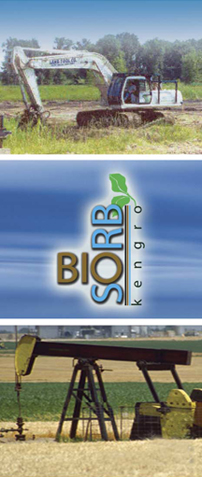 |

A Guide to In Situ and On Site Bioremediation For Hydrocarbon Contaminated Soils
These guidelines are designed to enhance and dramatically reduce the time necessary for destruction of the hydrocarbon contaminants by bioremediation.
If in doubt, consult with your distributor or manufactures representative.
Recommended steps:
| 1. |
For best results, the soil should be no thicker than 18 inches, and all soil aggregates should be broken up if possible. |
| 2. |
Apply Kengro Biosorb approximately 1 to 3% by weight. Try to maintain 15% moisture or approximately 70% water retention. |
| 3. |
Incorporate and till and water as needed (apply 13-13-13 fertilizer at a rate of 5 lbs per 100 sq. ft.) |
Example site:
Estimated site at 50’ X 160’ (8000 sq. ft.) would be 1/5 acre – contamination at least 12" deep with 170 barrels crude oil X 42 gallons per barrel = 7140 gallons (approximately 1 gallon / surface sq. ft.)
2" depth Kengro Biosorb = approximately 1 lb. kenaf to gallon of oil (1/6 of cu. ft. of Kengro Biosorb @ 5-6 lbs per cu. ft. – weight of Kengro Biosorb)
Assume soil sample 30 lbs /cu. ft. – 3% rate = 1 lb Kengro Biosorb/ cu. ft.
(soil density) 1.5% rate = _ lb kenaf / cu. ft.
2" application of Kengro Biosorb – 1 bag will cover 20 sq. ft.
1" application of Kengro Biosorb – 1 bag will cover 40 sq. ft.
Carefully till the soil pile with a small garden tractor, rototiller, or other suitable tool. Be sure to break up all large pieces of soil in order to aerate the soil (to provide oxygen) and thoroughly mix the Kengro Biosorb and fertilizer.
Moisten the soil pile by spraying water as for a garden (about 15 % moisture); be careful that soils are not saturated or flooded by the spraying, because run off may occur.
Once a month, at a minimum, the soil pile should be checked to be sure that cultivating the soil to introduce fresh oxygen and spraying water is not needed. New fertilizer should be added monthly to enhance microbial activity.
During more temperate times of the year (late spring, summer, and early fall), soil samples may be collected and analyzed to establish whether remediation is complete. Soil samples must be collected such that the entire pile has been characterized, and mixed together to form a composite. Bioremediation of the soils slows down during the winter months. During this time of year, existing projects should maintain their established schedule of tilling, fertilizing, and watering.
These steps of action described above are a generalized approach to biological remediation.
 |
|